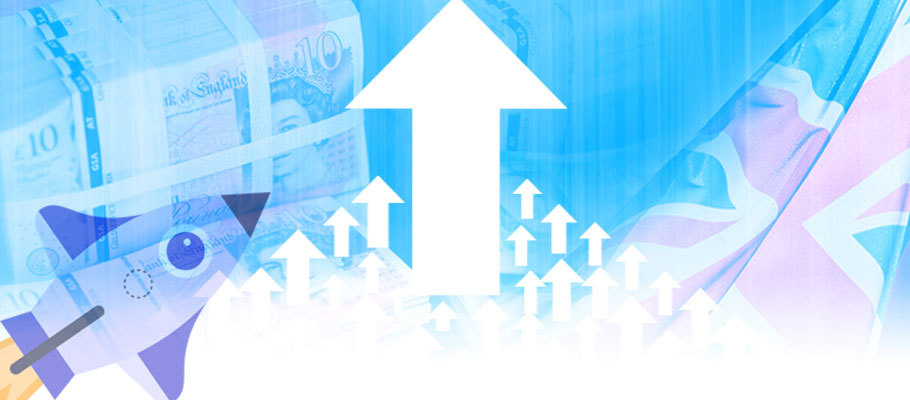
Published: January 26th, 2022
Sterling's strong start to the year is getting further support from inflation figures that came in above market expectations and a growing consensus amongst economists that other inflation surges are imminent.
British CPI inflation for December was 5.3 per cent year-on-year according to the UK’s Office for National Statistics (ONS), ahead of expectations for a reading of 5.1 per cent and exceeding the previous month’s 5.0 per cent.
Core CPI came in at 4.1 per cent, well in excess of the market's expectation for 3.8 per cent.
The surprise figures and the core CPI reading, in particular, are putting pressure on the Bank of England to take action. With a longstanding inflation target of 2.0 per cent, forex traders are beginning to bet on a February rate hike.
‘A rate rise next month now looks to be on the cards from the BoE,’ said CMC Markets in an analyst note. Inflationary pressures are so intense that CPI is now exceeding Threadneedle Street's target by more than it has at any point since 1993, the year the bank first established an inflation target.
It all makes for a supportive backdrop for sterling bulls. The GBP/EUR exchange rate pushed above 1.19 on Tuesday 25th January, while GBP/USD was up slightly on the previous day at 1.3589.
The BoE lifted rates on 16th December on worries that UK inflation might be stuck above the central bank’s two per cent target, raising prospects for another rate rise next month.
A growing chorus of economists now believe the Bank Rate could go as high as 1.24 per cent by year-end 2022.
Strategists at Barclays FX believe an 'aggressive' shift in expectations for higher rates means that sterling has already hit the levels of appreciation forecast by the bank for the first half of 2022. In a market analysis, they wrote that the extent of pound appreciation since Q4 of 2021 suggests traders should be cautious about chasing additional near-term gains.
But other currency strategists see sterling potentially leaping further ahead this year amid a mix of strong employment figures, high inflation, and a central bank prone to take more aggressive action on rates than it has through the pandemic.
According to ONS figures, the most significant sector contributors to December's high inflation reading were food and non-alcoholic beverages, furniture, transport, housing, and household goods.
This suggests that the pressure on British prices is widespread, pointing to price rises driven by external factors that Threadneedle Street can’t afford to ignore.
Barclay's is looking for a 25-basis point lift following the February Bank of England policy meeting. In their view, it could support further GBP rises. Inflation, meanwhile, probably hasn’t peaked yet.
Economists at ING in London told The Financial Times that rising inflation 'has some mileage left in it yet.
'While we can expect it to peak in the coming months, especially if the energy price cap is removed by Westminster as planned, markets also have to price in the impact of a cost-of-living crunch'. With prices rising and real wages falling, households might reign in spending, something sure to impact economic growth.
In response to the high inflation figures, UK Chancellor of the Exchequer Rishi Sunak said in a press release that the government 'understands the pressures ordinary people are dealing with due to pandemic-driven price rises.'
Analysts have warned that a cost of living crisis could be triggered if Westminster goes ahead with planned tax increases this year, which include a hike to the monthly National Insurance levy paid by all Britons. It’s set to rise in April.
A commentary published by the UK Confederation for British Industry (CBI) said that it's now 'urgent for the Government to develop solutions that will shield the most vulnerable consumers from further expected price rises'.
Solutions also must be found for businesses buckling under the weight of rising costs for materials and essential overheads like energy. The CBI also says that Westminster needs to develop a long-term strategy to manage the impact of energy market reforms and protect businesses from future energy price volatility.
Economists at City Macroeconomics have also brought their forecast for the BoE's subsequent Bank Rate increase forward to February on the back of the ONS inflation figures.
'With a headline rate 0.8 percentage points above the BoE's November forecast,’ action on interest rates will need to happen sooner than later.
City notes that inflation in the vital services sector is especially pronounced, hitting 3.3 per cent in December and pushing past the previous high recorded in July of 2013.
'The Monetary Policy Committee’s typical calculation of underlying services inflation has jumped to 3.0 per cent from 2.8 per cent and is now comfortably ahead of the 2.3 per cent average rate that dominated most of the 2010-2019 period'.
But City Macroeconomics also notes that sterling’s recent appreciation could also put downward pressure on the price of imported goods. As a net importer of fuel and commodities, a stronger pound could remove some of the sting from prices for vital imports.
‘It’s our view that the Bank of England will lift the Bank Rate by half the increase currently expected by markets,’ says City.
How far central bank policymakers are willing to go with interest rates will depend on how long UK inflation stays above the BoE's two per cent target.
Economists at ING said the ONS data shows that the UK’s annual rate of inflation in 2021 rose from 0.6 per cent at the start of the year to 5.3 per cent in December.
‘We believe inflation will lift above seven per cent by April, stay there through the Summer, and likely begin to dip again by August. That will still leave the inflation rate well above the two per cent threshold for action.